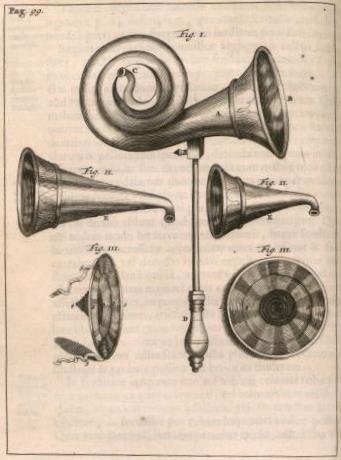
We might take it for granted that our hearing aids are hardly visible, can be controlled with our smart phones, and can differentiate between speech and background sound. What we may not realize, however, is that those features are the products of 400 years of experimentation, design, and enhancement.
Even 5 years ago, hearing aids could not produce the clarity of sound generated at present. To see why, let’s trace the history of hearing aids—beginning today and moving in reverse—to see how hearing aids would have handled your hearing loss in four different years: 2016, 1985, 1940, and 1650.
2016 – Contemporary Digital Hearing Aids
It’s 2016 and you’re searching to address your hearing loss. You launch an internet browser, search for a local hearing care professional, submit a quick form, and arrange a consultation.
At your hearing assessment, your hearing is tested using state-of-the-art computer technology that accurately assesses your hearing. Then, with the assistance of your hearing care consultant, you choose a hearing aid that accommodates your needs from a wide selection of models.
Then, your hearing specialist programs your new hearing aids to magnify only the sounds and frequencies you have difficulty hearing, giving you crystal clear sound without distortion.
If you were to tell someone in the 1980’s that this would be the process, they wouldn’t have thought it was possible.
So what did render it possible? In short, digital technology.
For most of their history, there was no way for hearing aids to discern between various sound frequencies. Hearing aids would magnify all inbound sound, including background noise, producing distorted sound.
The digital revolution solved that problem. With digital technology, all information can be transformed, saved, and manipulated as combinations of 0’s and 1’s. Digital technology enabled hearing aids to convert sound frequencies into digital information, which could then be sorted according to which sounds should be amplified (speech) and which should be suppressed (background noise).
The first all-digital hearing aid was created in 1995, and since then the technology has improved significantly, eventually to include wireless functionality.
1985 – Transistor Hearing Aids
Now it’s 1985 and you’re seeking to treat your hearing loss. You can forget about browsing for a local hearing care provider on the web because the first commercial internet service provider won’t be founded until 1989.
You’d need to use the phone book, rely on referrals, or drive around the neighborhood to find a hearing care practice.
After reserving a consultation and having your hearing tested, your options for hearing aids are quite restricted. Without the microprocessor and digital technology, hearing aids were constructed with a collection of transistors. This adds size and increased power requirements, leading to bigger batteries and massive hearing aids.
Additionally, without the benefit of digital technology, the hearing aid cannot differentiate between various frequencies of sound. Hearing aids receive inbound sound and the transistors act as basic amplifiers, amplifying all sound. So if you’re in a noisy room, speech recognition will be just about impossible.
1940 – Vacuum Tube Hearing Aids
It’s 1940 and you’re looking into acquiring a hearing aid. Transistors haven’t been applied to hearing aids yet, so your options are restricted to vacuum tube hearing aids.
Vacuum tubes consume more power than transistors, so the hearing aids demand larger batteries, making the hearing aids big, heavy, and awkward.
And once again, without digital technology, the hearing aids can only act as straightforward amplification systems, making all incoming sound louder. The hearing aids can’t enhance speech and can’t filter out background noise.
1650 – Ear Trumpets
Let’s travel all the way back to 1650. There’s no digital technology, no transistors, and no vacuum tubes. That means no way to transform sound into electrical currents that can be amplified.
With electrical amplification unattainable, your only option is mechanical amplification by concentrating and compressing sound into the ear canal, much like what takes place when you cup your hands around your ears.
By 1650, gadgets were developed that concentrated incoming sound into the ears, and these contraptions were named ear trumpets. They were large gadgets with a conical end that collected sound and a narrow end that concentrated the sound into the ear.
This would be the only technology readily available to people with hearing loss for the next 250 plus years.
Let’s return to 2016. Over the course of more than 400 years of history, hearing aids have progressed from mechanical amplification devices to electrical amplification devices, from vacuum-tube-based to digital-based. They’ve become considerably smaller, lighter, and more efficient and affordable.
They’ve also become much better at distinguishing between different types of sound, and in amplifying only certain kinds of sound (like amplifying speech while repressing background noise).
Every generation of hearing aid has made a major improvement over the previous generation. The question is, what’s the next major milestone in the history of hearing aids?
Will we soon be able to improve natural human hearing, rather than merely restore it?
